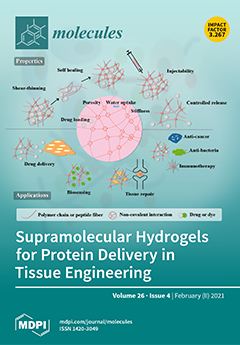Our present study was designed to investigate the role of both
Trichoderma harzianum and chamomile (
Matricaria chamomilla L.) flower extract in mutual reaction against growth of
Pythium ultimum. In vitro, the activity of chamomile extract was found to reduce the radial growth of
Pythium ultimum up to 30% compared to the control. Whereas, the radial growth reduction effect of
T. harzianum against
P. ultimum reached 81.6% after 120 h. Data also showed the productivity of total phenolics and total flavonoids by
T. harzianum, was 12.18 and 6.33 mg QE/100 mL culture filtrate, respectively. However, these compounds were determined in chamomile flower extract at concentrations of 75.33 and 24.29 mg QE/100 mL, respectively. The fractionation of aqueous extract of chamomile flower using HPLC provided several polyphenolic compounds such as pyrogallol, myricetin, rosemarinic acid, catechol,
p-coumaric acid, benzoic acid, chlorogenic acid and other minor compounds. In vivo, the potentiality of
T. harzianum with chamomile flower extract against
Pythium pathogen of bean was investigated. Data obtained showed a reduction in the percentage of rotted seed and infected seedling up to 28 and 8%, respectively. Whereas, the survival increased up to 64% compared to other ones. There was also a significant promotion in growth features, total chlorophyll, carotenoids, total polyphenols and flavonoids, polyphenol-oxidase and peroxidase enzymes compared to other ones. To the best of our knowledge, there are no reported studies that included the mutual association of fungus,
T. harzianum with the extract taken from the chamomile flower against
P. ultimum, either in vitro or in vivo. In conclusion, the application of both
T. harzianum and/or
M. chamomilla extracts in the control of bean
Pythium pathogen showed significant results.
Full article






